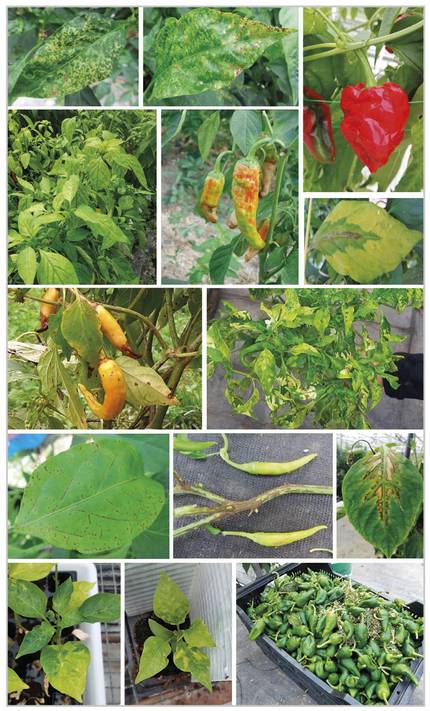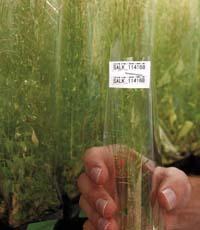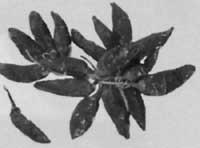smiling soldier anti-virus
2024/10/23 Ojinaga Juárez, Mikel - NEIKEReko ikertzailea, agronomia-ingeniaria eta Biologian doktorea Iturria: Elhuyar aldizkaria
Although pepper is a crop imported from America, the main types of peppers currently planted in the Basque Country, “Pimiento de Gernika” and “Guindilla de Ibarra” (Figure 1), are adapted to our agro-climatic conditions. They are an important part of our agro-diversity and have become products that are very closely related to the territory.
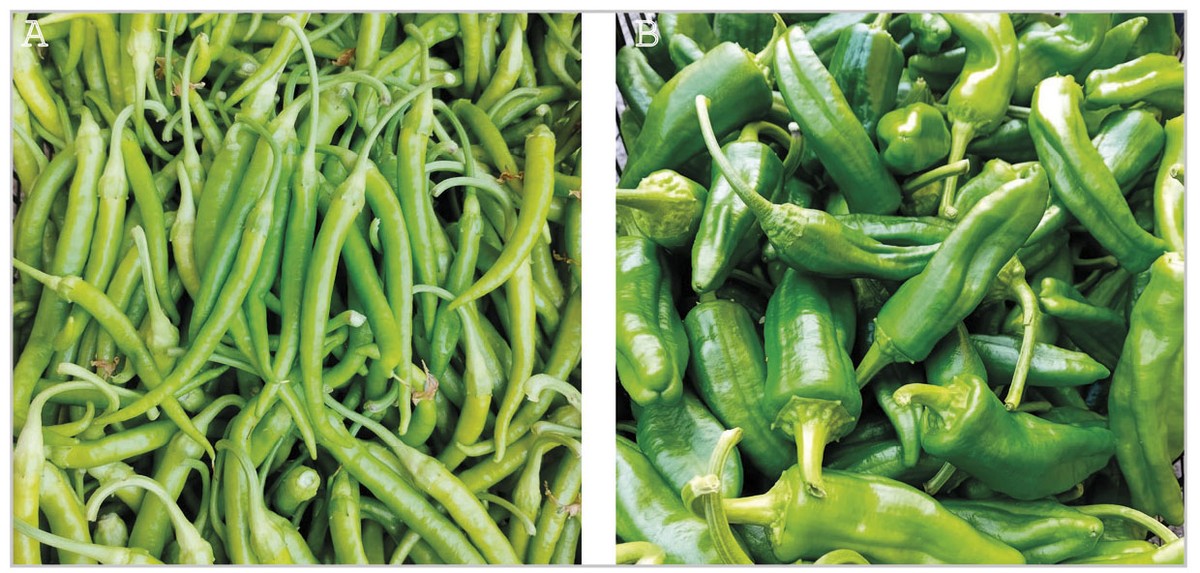
They are the varieties of peppers that ensure their origin and quality. Thanks to protected geographical indications or quality surveys, farms producing these products are competitive. In fact, they are known and appreciated for consumers, and the buyer is willing to pay higher prices for these peppers that indicate closeness and quality.
However, in the production and competitiveness of pimental farms several factors can influence, among which the problems of plant health stand out, highlighting the diseases caused by fungi and viruses. To a large extent, these diseases have been caused by the conventional intensive production system used in crops in recent decades.
A decade ago, local peppers and chilli peppers, along with industry technicians, contacted public administrations and horticultural researchers to inform them about the plant health problems they suffered in their crops, in order to find ways to deal with them. In fact, the sector was very concerned about the serious effects these diseases have on crops, with significant losses in production, which jeopardise the economic sustainability of farms (Figure 2).
Local varieties of virus-susceptible peppers and guindillas
First, it was decided to determine which virus caused the problems that were occurring in the plants. For this purpose, prospecting works were carried out in the farmers' peppers and chillies plantations. In Bizkaia and Gipuzkoa, mainly, greenhouse and orchard studies were carried out, plants with viral symptoms were sampled and later laboratory diagnostic studies were carried out. Seven viruses were analyzed using DAS-ELISA in over 1,000 plants. The viruses analyzed were the PVY potato virus transmitted by afidos (genus Potyvirus), the tomato drip virus TSWV transmitted by thrips (genus Orthotospovirus) and five viruses of the genus Tobamovirus transmitted by contact and seed. The tobamoviruses analyzed were as follows: Tobacco mosaic virus TMV, tomato mosaic virus ToMV, light green tomato mosaic virus TMGMV, light red pepper droplet virus PaMMV and light pepper droplet virus PMMoV.
Thus, the main virus agents present in the pimental plants were known. Some viruses appeared closely linked to greenhouses' plants, while others developed more in outdoor plants, some transmitted by insects and others transmitted from seed to the plant. In addition, the viruses that caused the most serious damage to the plants were identified. In outdoor plants, PVY was the one that generated the biggest problems. In greenhouses, viruses of the genus Tobamovirus and TSWV were the most prevalent. All analyses led tobamoviruses to be considered as the main threat in local varieties, as they are transmitted from seed to plant and then easily propagated by contact in plants during the handling of plants by farmers. Therefore, the yield and quality of the fruit is greatly reduced. The persistence of these viruses, which may be present for years in rural areas in a contagious way, is also noteworthy.
Defining the fundamental problem, solution: genetic improvement
Given the uncertainty caused by Tobamobirus, it was necessary to seek solutions for virus control, and the best option was to incorporate the genes of resistance to these viruses into the local susceptible varieties and to establish the necessary cultural measures in the plants that present these problems. Companies that market seeds never enter into investments to improve these types of varieties, because they are varieties of low commercial interest. In these cases, the role of public institutions dedicated to research and technological development is very important, as it is in their hands the improvement of varieties produced on a small scale. CUNHA OLIVEIRA (S). — (PT) Mr President, I should like to begin by congratulating Mr Cunha on his excellent report.
The resistance to tobamovirus of the bell pepper is regulated by a single main gene: Genes `L'. And several species and strains that carry it can be found in the genus Capsicum through four alleles (L1, L2, L3 and L4). On the other hand, tobamoviruses include several pathotypes (P0, P1, P1.2 or P1.2.3) that are classified according to their ability to overcome the resistance caused by the alleles of the `L' gene. As a result, viruses with P0 pathotypes cannot contaminate plants carrying the L gene. Viruses with pathotypes P1, P1.2 or P1.2.3 can contaminate plants with L1, L1 and L2 and L1, L2 and L3 alleles respectively (Table 1).
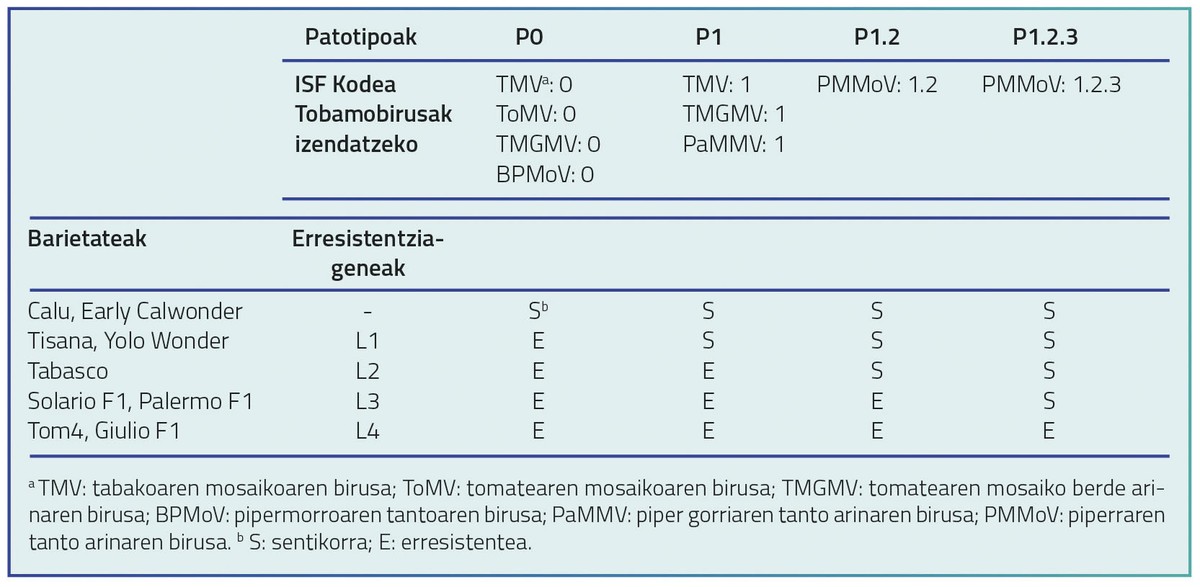
The varieties containing these resistance genes `L´ begin at the point of contact with tobamobirus the process called “hypersensitive response”, in which the plant favors programmed cell death and prevents the development of the virus (Figure 3).
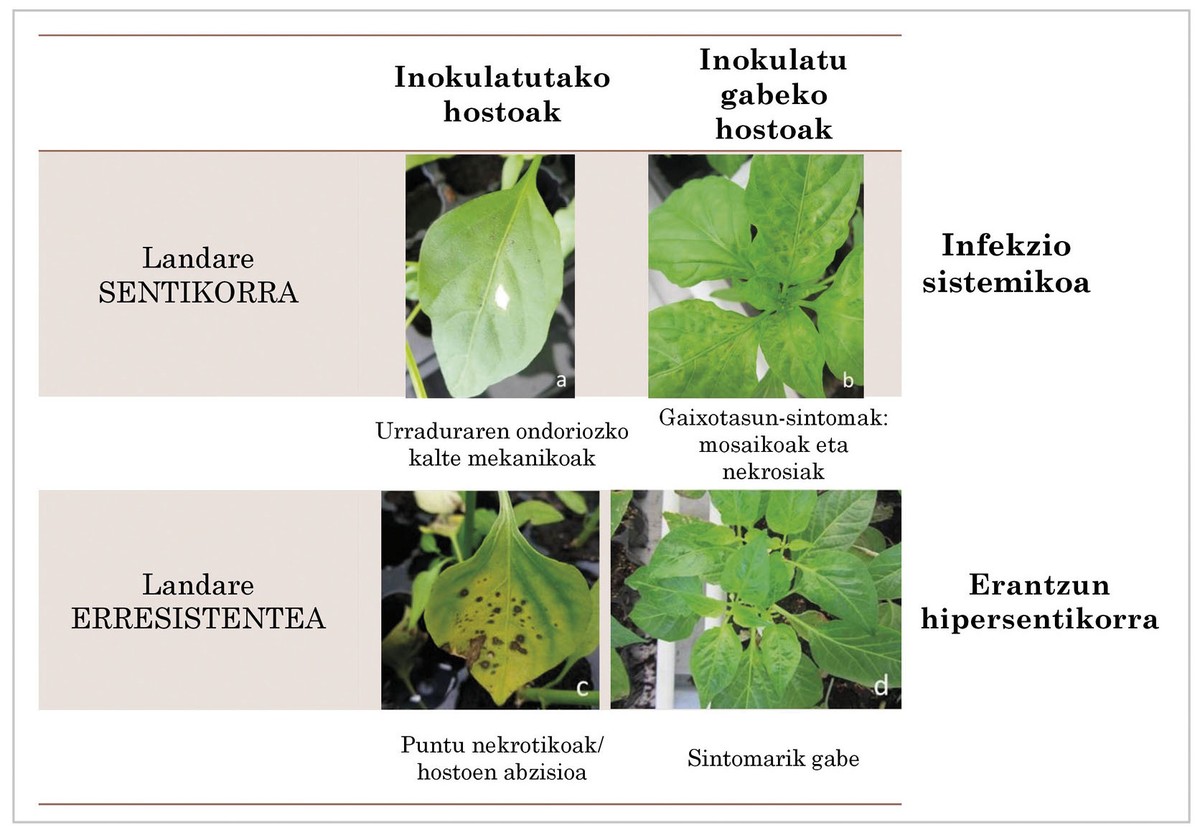
In the survey carried out in 2014, after inoculation of 36 samples contaminated with tobamovirus PMMoV of varieties with different alleles of the gene `L', it was observed that with the allele L3 all tobamovirus affecting the papal plant of the Basque Country could be controlled (Table 1). However, it was decided to introduce genes L3 and L4 in a differentiated way in the two native varieties, so that in the future more tobamovirus could be controlled that could enter the papal plants of the Basque Country.
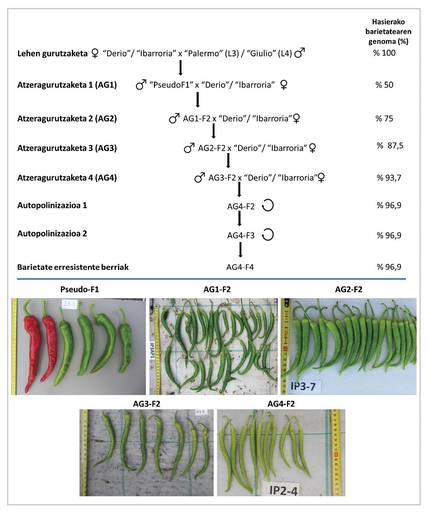
A backward program assisted by molecular markers is underway
Thus, in 2015, a classical genetic improvement program was launched based on Mendel's laws and crosses through the regression assisted by molecular markers (MMLAG) (Figure 4). On the one hand, a mother pepper, a nice bell pepper from Gernika, with quality label, very appreciated in the market and valued in our kitchens and tables. On the other hand, another mother pepper, Ibarra's fine chili peppers, ideal for frying or eating vinegar. The two varieties were crossed with sweet peppers of Italian origin, which had genetic resistance to the viruses: “Palermo” (gene L3) and “Giulio” (gene L4). The ultimate goal was for the succession to have an agronomic aspect and characteristics of the mother and receive the genetic resistance of the father. For this first crossing, pollen from resistant hybrid varieties was unified and placed in castrated flowers of susceptible varieties to enable crossing between varieties (Figure 5).
At the first crossing, 50% of the genome of the native strains was lost, but at the same time it was possible to introduce the resistant gene to half the succession (Figure 3). Afterwards, in the folds, resistant plants were selected and the original genome was recovered. The selection of resistant plants was carried out by means of molecular markers associated with resistance genes in all generations of the improvement program. Thus, given that in each reversal performed in the improvement program, 50% of the genome of the autochthonous varieties is recovered, after the execution of four and after the recovery of almost 97% of the genome of the interested varieties, it was decided to include genes L3 and L4 in homosurgery by means of two autopollinations (Figure 4). These varieties are not transgenic, in any case, but those produced by crossing and selection.
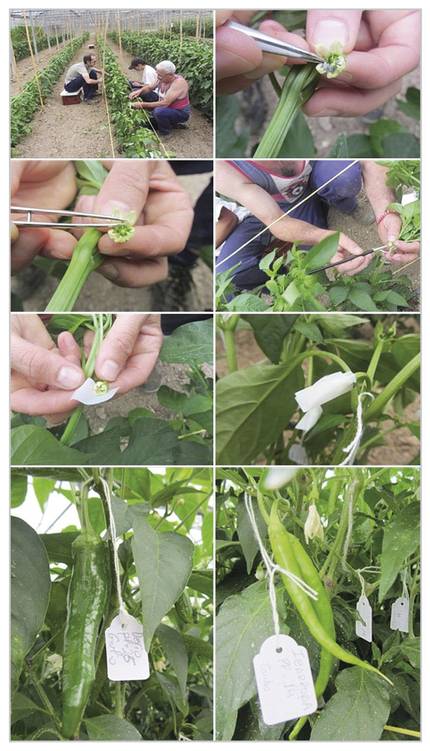
New resistant varieties: GUDARI and IRRIBARRA
These improvement programmes involve long-term work. In this case, 7 vegetable cycles were needed to obtain peppers and chilli peppers that were very resistant to the mother. However, instead of doing things the way Mendel did in his day, in this case molecular markers have been used. Thus, specific molecular tools were developed and used to obtain information about the genetic resistance of the succession in a agile and effective way and to expedite the process. On the other hand, in two years the productive behaviour of the new resistant varieties was evaluated through tests, and it was found that they were capable of producing at the same time as the two original susceptible varieties. The most successful resistant strains developed were selected in the tests. In addition, the behavior of these peppers in commercial cultures was analyzed, especially in farms with virosis problems, with high levels of productivity and resistance. Finally, viral inoculations were performed to ensure that the new varieties are resistant to tobamoviruses. Gernika's new bell pepper was called GUDARI, referring to the work, vocation and passion needed to solve the problems. But Ibarra's resilient guindilla was called IRRIBARRA, a variety to which we want a happy and productive future. These are two varieties created taking into account our ancestors, in the face of today's problems and future solutions. But, in order for resistance to be durable over time, it is desirable that the viral load of orchards and greenhouses be as low as possible. Thus, a protocol of hygiene practices on farms has been agreed to minimise viral load and minimise the risk of resistance overturning due to new strains of the virus.
Solving new problems
Native varieties of peppers and peppers that will fight off tobamoviruses have been obtained. The damage to producers has decreased considerably and in this way the economic profitability of farms has been partly recovered. However, in recent years, the area of cultivation has decreased, especially in Bizkaia (the area linked to the Gernika pepper has been drastically reduced). From now on, it will be essential that socio-economic problems related to agricultural production be solved, to ensure the generational relief of the horticultural sector of the Basque Country and to guarantee in the future the supply of valuable food for the citizens.
Acknowledgements
I would like to thank Santiago Larnorma, director of my PhD thesis, for having obtained the necessary resources to do this work, and Sorkunde Mendar for encouraging them to participate in this award. Xabi Ojinaga, Aitor Marcos and Igone Menika have also participated in the text.
Bibliography
[1] Tomita R, Murai J, Miura Y, Ishihara H, Liu S, Kubotera Y, Honda A, Hatta R, Kuroda T, Hamada H, et al. Fine mapping and DNA fiber FISH analysis locates the tobamovirus resistance gene L3 of Capsicum chinense in a 400-kb region of Rlike genes cluster embedded in highly repetitive sequences. Theor Appl Genet. 2008;117(6):1107-18 Doi: 10.1007/s00122-008-0848-6.
[2] Tomita R, Sekine KT, Mizumoto H, Sakamoto M, Murai J, Kiba A, Hikichi Y, Suzuki K, Kobayashi K. Genetic basis for the hierarchical interaction between Tobamovirus spp. and l resistance gene alleles from different pepper species. Mol Plant Microbe Interact. 2011;24(1):108-17 Doi: 10.1094/MPMI-06-10-0127.
Di Dato F, Parisi M, Cardi T, Tripodi P. Genetic diversity and assessment of markers linked to resistance and pungency genes in Capsicum germplasm. Euphytica. 2015;204:103–119. exactly: 10.1007/s10681-014-1345-4.
[4] Genda Y, Kanda A, Hamada H, Sato K, Ohnishi J, Tsuda S. Two Amino Acid Substitutions in the Coat Protein of Pepper mild mottle virus Are Responsible for Overcoming the L(4) Gene-Mediated Resistance in Capsicum spp. Phytopathology. 2007 Jul; 97(7):78793. doi: 10.1094/PHYTO-97-0787.
Dombrovsky A, Smith E. Seed transmission of Tobamoviruses: Aspects of global disease distribution. In: Advances in Seed Biology. Adjustment 2017: 10.5772/intechopen.70244.
[6] International Seed Federation. Differential sets in Tobamoviruses. Nyon (Switzerland) February 2020.

Gai honi buruzko eduki gehiago
Elhuyarrek garatutako teknologia




